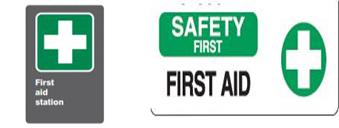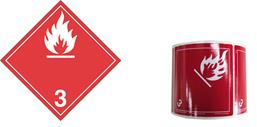Today, visual advertising through posters, especially in the workplace, is a reality that cannot be ignored. How do you get your message heard and hold the attention of all workers? See even for all people circulating on or near a workplace.
On your future posters, you will need to know exactly. Who is the target audience for the poster? What to do if the graphic codes chosen do not correspond to your target audience? Do you know exactly what messages are reaching people in your organization?
What is the purpose of your safety sign?
What or who is it about?
Where will the sign be seen?
Under what circumstances?
What tone, what atmosphere will the poster have?
Which graphic charter should be respected?
The choice of the dimensions of your poster is also important: depending on the location and the context of the display, but also on the supports chosen, you must select an appropriate size.
Do you need a small poster that can be stuck behind the window, a poster in a bus shelter, a large format for an outdoor billboard?
No need to weigh down your composition with unnecessary colour elements, a well-thought-out safety poster should above all use the colours and more generally the graphic codes of the messages they refer to.
The typographical rules for health and safety posters are the same as for most graphic creations. Do not overdo it.
By following these tips, you will have a good basis for the success of your relevant and effective health and safety poster that will convince your target audience.
However, your poster must be finely crafted. Sylprotec is certainly an organization capable of developing your health and safety posters for you.
SIGNAGE IS ONE OF THE FACETS OF YOUR POSSIBLE NEEDS.
Health and safety signage can be realized in many ways. It is possible to use signs that will comply with current regulations, particularly regarding colors. It is also possible to use light or sound signals.
But why put up signs?
It is necessary in a workplace when a risk cannot be avoided or prevented by the existence of collective protection or by the organization of work.
Signalling can also affect the marking of the traffic lanes where the activity is carried out to inform carriers or visitors to the presence of risk.
It also serves to inform about risks by means of warnings, obligations, prohibitions and emergency information (accidents, fire). Depending on the risk assessment and its prevention policy, the employer may have recourse to occasional signs (light or acoustic signals).
The signs must be:
– as simple as possible, without unnecessary details for comprehension
– installed “in a well lit, easily accessible and visible location,”
– Their dimensions must ensure good visibility.
You can also use the signs of the Highway Code to indicate obligations (pedestrians, speed limits, prohibited direction…).
PICTOGRAMS
All the useful pictograms can be consulted on the Sylprotec website in the DISPLAYS segment. Posters in accordance with CSA regulations (Canadian regulations) use more pictograms and less text. As long as the OSHA posters (American regulation) it uses more text and fewer pictograms.

On the one hand, you can find:
– 253 models of workplace accident prevention posters in several categories in prevention, health and safety and visible on Sylprotec’s website at https://www.sylprotec.com/en/.
– On the other hand, it will also be possible to offer you solutions to put up your posters and/or general safety instructions in several sectors of economic activity.
– Sylprotec has been working for several years with communication specialists to work with you on strategies to reduce your workplace accidents.
– Sylprotec offers you the full range of posters that are commonly used and comply with the Construction Industry Safety Code, the Building Code, the Workplace Hazardous Materials Information System (WHMIS) and the Transportation of Dangerous Goods (TDG).

SOME SECTORS OF ECONOMIC ACTIVITY
There are several sectors of economic activity that already have regulations that specifically address signage and the use of signs.
We will focus here on just a few areas that govern employers’ obligations in these areas.
– CONSTRUCTION INDUSTRY SAFETY CODE (CSIC)
– NATIONAL BUILDING CODE (NBC), RÉGIE DU BÂTIMENT DU BÂTIMENT (RNB)
– WORKPLACE HAZARDOUS MATERIAL INFORMATION SYSTEM (WHMIS)
– TRANSPORT OF DANGEROUS GOODS (TMD).
– CANADIAN STANDARD ASSOCIATION (CSA)
– NATIONAL INSTITUTE FOR OCCUPATIONAL SAFETY AND HEALTH (NIOSH)
– COMMISSION DES NORMES, DE L’ÉQUITÉ, DE LA SANTÉ ET DE LA SÉCURITÉ DU TRAVAIL (CNESST)
– FIRE CODE (FCP)
– Etc.
Most of these Acts or Codes are the result of a large number of different regulations depending on the various sectors affected.
Some examples of regulations:
Safety code in the construction industry.
NOISE
Signage: When a worker is exposed to noise that exceeds the established standards, the employer must post a sign near the workstation where the worker is located indicating that hearing protection must be worn.
ON A CONSTRUCTION SITE
In a work site where moderate risk work is carried out, the employer shall install
A sign at each work access; this sign shall be yellow, 500 mm high and 350 mm wide and shall indicate, by means of black characters of the dimensions specified below, the following information in the same order:
Information Size of characters
Asbestos 50 mm
DANGER 40 mm
Do not breathe dust 15 mm
Protective equipment
Mandatory 15 mm
Prohibited entry 15 mm
Inhaling asbestos dust can be harmful to your health 10 mm;
In the absence of an enclosure, it must delineate the work area with hazard signs.
NATIONAL BUILDING CODE (NBC), RÉGIE DU BÂTIMENT (RNB)
Use, storage and distribution of propane in containers.
The tank of a propane supply system in a road vehicle can only be filled if the vehicle has the appropriate sticker and is required to be refilled under the Regulation respecting safety standards for road vehicles.
Signs bearing the international “NO SMOKING” sign or symbol must be prominently displayed at all entrances and propane transfer points at fuelling stations. The letters must be red on a white background or black on a yellow background and be at least 100 mm high. Symbols must have a minimum diameter of 300 mm.
Signs bearing the following words shall be prominently displayed on or near the tank and at the point of transfer, when the transfer takes place more than 3 m from the tank at a propane container filling stations, so as to be visible from that point:
Pumping station
The words “NO SMOKING, CUT-OFF ALL SOURCES OF LIGHTING” and the letters must be at least 50 mm high.
The words “WHEN TRANSPORTING, SOLIDLY SECURE BOTTLES IN VERTICAL POSITION IN A VENTILATED LOCATION” and the letters must be at least 25 mm high;
The words “PROHIBITED TO FILL PROPANE BOTTLES AND ENGINE FUEL RECIPIENTS WITH A CAPACITY EXCEEDING 80% OF THEIR TOTAL VOLUME CAPACITY” and the letters must be at least 25 mm high;
The words “NO SMOKING IN a 3-METRE RANGE ¬ CUTTING THE ENGINE DURING FILLING” in the case of a vehicle propane distribution site and the letters must be at least 25 mm high.
The international symbols meaning “NO SMOKING” and “ENGINE CUT-OFF,” measuring at least 100 mm in diameter, may be used in lieu of these terms. These symbols shall be red and black on a white background.
The letters on the posters must be red on a white background or black on a yellow background.
No sign shall indicate to a customer of a supervised self-service station using a fuel dispenser after September 28, 2007, that they must reduce the dispensing flow rate after the trigger of the nozzle is automatically triggered.
Provisions applicable to deposits
The property owner must post a sign at the main gate bearing his or her name, address and telephone number, or those of his or her authorized representative.
The owner must prominently display in the main building of a depot the telephone numbers of the police, fire and ambulance services.
The owner shall post a sign at loading ramps and near each emergency switch in a prominent place indicating the location of emergency switches and instructions for the operation of firefighting equipment.
In the case of a depot equipped with equipment, it shall also provide these procedures to any person who has a key.
In addition, they must post these keyed dispensing or loading procedures in the main building where the depot is located.
Roundabouts
When users move around in the dark inside an enclosure or in the case of a game or ride consisting of a fully enclosed enclosure, the enclosure must be equipped:
(1) a smoke alarm bearing the Underwriters’ Laboratories of Canada (ULC) seal of approval installed in accordance with the manufacturer’s instructions. The smoke alarm shall be checked for the proper operation each time a portable game or ride is installed and monthly in other cases;
– Signs, visible from the vehicle, indicating exits;
An emergency lighting system with an intensity of at least 10 lux, at floor level and signs indicating exits, activated automatically when the main source of electrical power is interrupted.
In addition, each exit door shall be marked “EXIT” in letters not less than 25 mm high and, if locked, shall be capable of being opened from the inside of a single operation without the use of a key.
Often we are looking for a helping hand to help us with some of our decisions. On that note, I can say without hesitation that this organization has had a signature to its name for several years now. Indeed, its president has made it his mission to help those who are looking for specific information but cannot find it on their own.
If you don’t know what to do or how to do it, this organization will listen to your needs and support you in your search. Many organizations claim to offer this type of assistance, but few offers support of this quality.
Sylvain Patrice f.p.t.
By the same author:
Where should I install my portable fire extinguisher in my building?
The rules regarding the height at which your portable fire extinguishers must be attached.
How many fire extinguishers do I need to install and what size extinguisher should I choose?
Steps for performing an inspection on portable fire extinguishers.
Emergency lighting the principles of operation.
